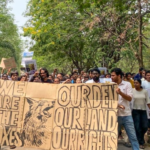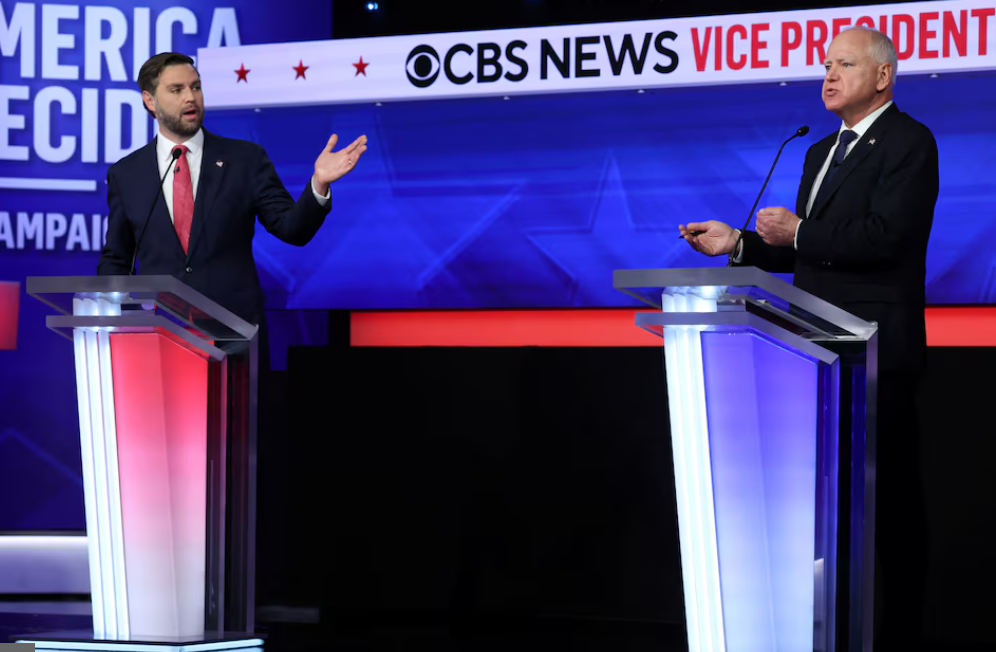Walz and Vance clash, politely, at policy-heavy vice presidential debate
The vice presidential debate between Ohio Sen. JD Vance and Minnesota Gov. Tim Walz was a rare sight in today’s politics. The two were friendly with each other, aiming their criticisms at the opposing tickets. They mainly talked about policy differences.
Vance attacked Vice President Kamala Harris on border security. Meanwhile, Walz criticized former President Donald Trump on abortion rights.
The debate covered many domestic topics, like the economy, immigration, and gun violence. Yet, the atmosphere stayed respectful. Both Walz and Vance steered clear of personal attacks, diving into detailed policy discussions instead.
Key Takeaways
- The vice presidential debate between Walz and Vance was a policy-driven affair, with the candidates avoiding personal attacks.
- Walz and Vance clashed on issues like border policy, abortion rights, and the January 6th Capitol attack, but maintained a cordial tone throughout.
- Snap polls showed a 50-50 split among voters on who won the debate, with Walz performing better among independents.
- Vance repeatedly referred to Harris as Biden’s “border czar,” while Walz criticized Trump’s Supreme Court appointments on abortion rights.
- The debate highlighted the policy differences between the two tickets, with Walz and Vance taking distinct stances on a range of domestic issues.
Debate Highlights: No Clear Winner Emerges
The vice-presidential debate between Democrat Tim Walz and Republican JD Vance was highly anticipated. It left voters divided, with no clear winner. Snap polls showed the audience was split 50-50 on who did better.
Independents Favored Walz, Giving Him a Commanding Advantage
However, a closer look at the data reveals an interesting twist. Walz won over independent voters, with 58% choosing him over Vance’s 42%. This shows that while the overall result was even, Walz’s performance appealed more to a key voting group.
| Candidate | Overall Audience | Independent Voters |
|---|---|---|
| Tim Walz | 50% | 58% |
| JD Vance | 50% | 42% |
The debate lasted 90 minutes in midtown Manhattan. It highlighted the policy differences between the candidates. With no clear winner emerging and snap polls showing a 50-50 split, it showed the race is close. Independents favoring Walz could give him a big advantage.
Vance Avoids Directly Answering on 2020 Election
The biggest disagreement of the night was about the 2020 election. Walz asked Vance if he believed Trump lost the election. Vance dodged the question, saying he was “focused on the future.”
Walz called Vance’s answer a “damning non-answer.” He said Trump’s actions were a big threat to democracy. Vance then shifted the topic, criticizing “censorship” by “big tech companies.”
Walz Presses Vance on Acknowledging Trump’s Loss
Walz tried hard to get Vance to admit Trump lost the 2020 election. This fact is backed by lots of evidence and court rulings. But Vance wouldn’t say Trump was defeated.
Vance Pivots to Criticizing “Censorship” and “Big Tech”
When Walz kept pushing on the election, Vance changed the subject. He talked about his concerns with “censorship” by big tech. He claimed these companies unfairly target conservative voices. But this claim is not supported by strong evidence.
Vance’s refusal to talk about the 2020 election was a key moment. It showed how deep the divide is on this issue. Walz’s push for Vance to be honest about the election outcome showed the hard work needed to find common ground on democratic values.
Cordial Tone Prevails Despite Policy Disagreements
This vice presidential debate showed how Americans usually talk about tough topics. There were no personal attacks or mean jokes. Both Vance and Walz were told to keep the debate focused on the issues, not each other.
They talked about serious topics like immigration and gun violence. They showed they understood the issues were complex. They discussed their views without attacking each other personally. This made the debate more in-depth and helped viewers see different sides.
“We may not agree on everything, but we can disagree respectfully and focus on finding common ground where possible,” said Vance during the debate.
Walz also said, “While we may have different views on how to address these challenges, we share a common goal of improving the lives of all Americans. That’s what should guide our discussion.”
The debate’s friendly atmosphere, despite disagreements, is what Americans aim for. This debate showed how opponents can talk about tough topics respectfully. It’s a good example of how to have a constructive conversation, even when you disagree.
Immigration Takes Center Stage
Immigration became a key topic in the debate. Tim Walz and JD Vance discussed their parties’ views. Walz quickly pointed out Vance’s repeated false claims about Haitian migrants.
Vance argued that the Biden administration’s border policies are failing. He called Vice President Kamala Harris the administration’s “border czar.” Walz countered by saying Trump blocked a bipartisan border bill. He claimed Trump did this to keep immigration a campaign issue.
The debate grew intense, with Vance trying to make the Republican Party seem more appealing. Walz, however, continued to criticize Trump’s immigration policies. The debate was so heated that the microphones were briefly cut.
Walz and Vance’s disagreement on immigration showed the big gap between the two parties. The debate showed the complexity of immigration in the U.S. The audience was left to think about the different views on this important issue.
Walz and Vance clash, politely, at policy-heavy vice presidential debate
The debate between Ohio Sen. JD Vance and Minnesota Gov. Tim Walz was different. It was a break from the usual fights in politics. Both candidates were polite, focusing on their opponents rather than personal attacks.
The debate was all about policy. They talked about immigration, abortion, and foreign policy. Both showed they knew a lot about these topics, offering detailed plans. Despite their differences, they kept the debate respectful.
“This is how our political discourse should be,” said one political analyst. “The candidates put aside their partisan differences and engaged in a genuine exchange of ideas. Voters deserve this level of substantive engagement from their leaders.”
The debate showed what politics could be like if it was more civil. It’s not often that debates change how people vote. But Walz and Vance’s approach might appeal to those wanting a better political process.
With big issues like the Middle East and COVID-19, leaders need to work together. The debate was a sign that finding common ground is still possible, even with big differences.
Abortion Divide: States’ Rights vs Human Rights
Tim Walz and J.D. Vance had different views on abortion rights. Vance thought states should decide on abortion laws. Walz saw it as a human rights issue, pointing out high maternal death rates in strict states.
Vance wanted states to make their own abortion laws. He believed in respecting different values across the country. Walz, however, saw abortion as a basic human right that needs national protection.
Vance Argues for State Decisions, Walz Frames It as Human Rights Issue
Vance believed in states’ rights over a federal abortion policy. He thought the U.S.’s diverse culture and politics needed a state-by-state approach to abortion.
Walz, though, saw it as a human rights issue. He pointed out the high maternal death rates in strict states. He argued that reproductive healthcare is a basic human right, no matter what states decide.
| Vance’s Stance | Walz’s Stance |
|---|---|
| Supports state-level decision-making on abortion | Views abortion access as a human rights issue |
| Emphasizes the need to respect diverse regional values | Cites rising maternal mortality rates in restrictive states |
| Believes states should have the authority to regulate abortion | Argues for a national policy to protect reproductive rights |
The debate between Walz and Vance showed a big divide. It’s between those who value states’ rights and those who see it as a human rights issue. This disagreement shows the challenge of balancing state freedom with national rights protection.
Gun Violence Addressed in Relatively Constructive Exchange
In a surprising turn, Vice Presidential candidates Tim Walz and JD Vance had a constructive talk on gun violence. This was a rare moment of agreement in a campaign filled with disagreements. They both agreed that gun-related crimes and tragedies need urgent attention.
Walz, a Democrat, said, “Gun violence is a critical issue we must tackle. No family should fear losing a loved one to violence.” Vance, the Republican, also showed concern, saying, “We all want fewer gun incidents and a safer country.”
The candidates talked about possible solutions. They mentioned stronger background checks, more mental health support, and bipartisan gun laws. Even though they didn’t agree on everything, their conversation was a refreshing change from usual debates.
| Key Gun Violence Statistics | Value |
|---|---|
| First gun-control statute in the United States | 1619 |
| Nation’s first militia statute | 1623-1624 |
| Anglo-America’s first Aliens Restriction Act | 1632 |
| Mandatory census of inhabitants and possessions, including guns | 1619 |
| Voting rights for elite white women taken away | 1699, 1705 |
This constructive talk on gun violence offered hope in a tense political climate. It showed that gun violence addressed and constructive exchange are possible, even with big differences between parties.
“We all want to see a reduction in gun-related incidents and a safer country for our citizens.” – JD Vance, Republican Vice Presidential Candidate
Vance Hits Harris on Failure to Implement Policies
During the vice-presidential debate, Senator JD Vance of Ohio criticized Vice President Kamala Harris. He asked why she hasn’t put many of her policy plans into action, even though she’s been in office for over three years. Vance said some of Harris’ ideas were “halfway decent,” but he pressed her on the lack of progress.
Vance aimed to link Harris to the Biden administration’s record. He countered criticisms of former President Trump’s presidency. By pointing out Harris’ failure to act on her proposals, Vance wanted to show the Republican ticket as a better choice.
Pivots to Why Harris Hasn’t Enacted Proposals as VP
Vance often changed his attack to why Harris’ ideas haven’t been put into action. This was meant to question Harris’ credibility. It suggested the Biden-Harris administration hasn’t followed through on its promises.
- Vance argued that Harris’ “halfway decent” proposals have been ignored, leaving voters wondering why they haven’t been acted on.
- He tried to show Harris as a figurehead who hasn’t made real changes, despite her influence.
- Vance’s criticism aimed to make the Republican ticket seem more capable of turning policy goals into real results.
By constantly pointing out Harris’ failure to act on her proposals, Vance tried to shake public trust in the Biden-Harris administration. He hoped to make the Republican ticket seem like a more dependable choice for voters.
Walz Acknowledges Misstating China Travel Claims
During the recent vice presidential debate, Governor Walz faced questions about his China travel claims. New reports questioned his statements, which said he visited China about 30 times.
Walz then admitted he “misspoke“. He said he actually went to China around 15 times, not 30. This change surprised many, as his earlier claims seemed to show a lot of engagement with China.
“I misspoke on the number of times I traveled to China. The actual number is likely closer to 15 times, not the ‘about 30 times’ I had previously stated.”
This clarification shows how crucial it is to check facts, especially with politicians. It reminds us that even experienced leaders can make mistakes. This highlights the need for truth and fact-checking in politics.
As the campaign goes on, voters will pay more attention to these details. Walz’s admission about his misstating China travel claims could affect how people see him. This might be especially true for issues like foreign policy and international relations.
Conclusion
The debate between Tim Walz and JD Vance showed a rare moment of constructive talk in American politics. They disagreed on big issues like the 2020 election and abortion rights. Yet, they mostly stayed away from personal attacks, focusing on their running mates instead.
This debate might not change the presidential race much. But it gave voters a chance to see a detailed discussion between the two vice-presidential candidates. It was a chance to focus on policy rather than personal attacks.
During the 90-minute debate, Walz and Vance shared their ideas in a fair way. They talked about their plans for about half the time. People seemed to like Walz’s ideas more, with 55% favoring them over Vance’s 45%.
Social media buzzed with over 5,000 tweets per minute about the debate. This shows how interested people were in the policy discussions.
Even though the debate was civil, there were some tense moments. For example, Vance dodged a question about the 2020 election. Still, the debate was seen as a positive step towards better political talks.
As the November election approaches, this debate could be a good example. It showed how to have a thoughtful and policy-focused conversation in politics.
FAQ
What was the overall tone of the vice presidential debate between Walz and Vance?
The debate was seen as “normal” and “cordial”. The candidates mainly attacked the opposing presidential candidates. They focused on policy differences and avoided personal attacks.
Was there a clear winner in the snap polls after the debate?
No, the snap polls showed a 50-50 split. Walz had a strong lead among independent voters.
How did Walz press Vance on the 2020 election results?
Walz asked Vance if Trump had lost the 2020 election. Vance dodged the question, criticizing “big technology companies” instead. Walz called this a “damning non-answer”.
How did the candidates address the issue of immigration and border security?
Vance called Vice President Kamala Harris the Biden administration’s “border czar”. Walz criticized Trump for blocking a bipartisan border security bill. He also mentioned Vance’s false claims about Haitian immigrants.
How did Walz and Vance address the issue of abortion rights?
Vance said abortion rules should be left to the states. Walz saw it as a basic human rights issue, citing high maternal mortality rates in states with restrictions.
How did the candidates address the issue of gun violence?
Vance and Walz agreed that gun violence is bad and getting worse. This was a rare moment of agreement in the debate.
How did Vance criticize Vice President Kamala Harris?
Vance questioned why Vice President Kamala Harris hasn’t implemented her policy proposals. He acknowledged some of her ideas are “halfway decent” but wondered why she hasn’t acted on them.
Did Walz acknowledge any mistakes in his previous statements?
Yes, Walz corrected his earlier claims about traveling to China. He said he had “misspoken” and the number of trips was likely closer to 15.
धर्म बदलकर बनी मुसलमान फिर रचाया 4 बच्चों के बाप से निकाह, 44 सालों से नहीं गई ससुराल हेमा मालिनी











